
Endodontic treatment of a severely worn premolar
23/10/2021
Francesca Cerutti
Warning: Undefined variable $post in /var/www/vhosts/styleitaliano-endodontics.org/endodontics.styleitaliano.org/wp-content/plugins/oxygen/component-framework/components/classes/code-block.class.php(133) : eval()'d code on line 2
Warning: Attempt to read property "ID" on null in /var/www/vhosts/styleitaliano-endodontics.org/endodontics.styleitaliano.org/wp-content/plugins/oxygen/component-framework/components/classes/code-block.class.php(133) : eval()'d code on line 2
Sometimes endodontics is the first answer to the needs of our patients, in particular when they come to our practice because they feel pain.
Apart from freeing the patient from pain, the aim of endodontic treatment is to shape the root canal system, put in action an efficient disinfection protocols and to hermetically obturate the canal space. This last step is essential for the long term success of the treatment, because an efficient seal avoids bacterial recolonization of the root canal system: to reach this goal, sealers are used to enhance the quality of the obturation.
Sealers have the function to fill the voids and gaps between the obturation core material and the walls of the root canals, following the anatomic irregularities of the root canal systems, preventing micro-leakage and entombing any remaining micro-organisms. According to their flow ability, different sealers will be more or less capable to penetrate into lateral canals, isthmuses, etc. Sealers of different nature exist on the market, but all of them aim to be biocompatible, have no shrinkage with setting, be easy to handle and with a slow setting time, to work as a lubricant for the filling core and to penetrate into dentinal tubules. An ideal sealer should also be radiopaque, have the capability to adhere to the dentine and the core material, be bacteriostatic, soluble in solvents, insoluble to oral and tissue fluids, to facilitate the placement of the filling core with a lubricant action and to avoid staining the tooth.
The Literature has pointed out some drawbacks of ZOE sealers, such as the capability to stain the tooth and to have a setting time depending on the heat/humidity of the environments. In order to improve ZOE powder-liquid sealers, many attempts have been done, adding various substances or substituting Eugenol in the liquid component. In 2019 a new sealer containing Tea Tree essential Oil (EssenSeal, Produits Dentaires SA, Vevey, Switzerland) has been launched on the market.
Tea Tree Oil is the essential oil obtained from the Australian native Melaleuca alternifolia. It has been shown to possess anti-inflammatory activity and antimicrobial activity against a wide spectrum of microorganisms, a range of oral bacteria, certain viruses and many fungi including some azole-resistant yeasts. TTO has also demonstrated a potential biofilm inhibiting activity.
EssenSeal (Produits Dentaires SA, Vevey, Switzerland) is easy to mix and to handle, its white color prevents from staining the tooth, has a good flow ability and antibacterial properties due to its tea tree oil content. Moreover, it is sufficiently radiopaque, insoluble in oral fluids but easy to remove in case of retreatment.
The following case report will show the endodontic treatment of a severely worn premolar in a patient with severe bruxism and loss of vertical dimension.

Fig. 1
The pre operative orthopantomography shows the presence of severely worn teeth due to bruxism. The patient came to my attention complaining about acute, spontaneous pain in the lower right hemi-arch.
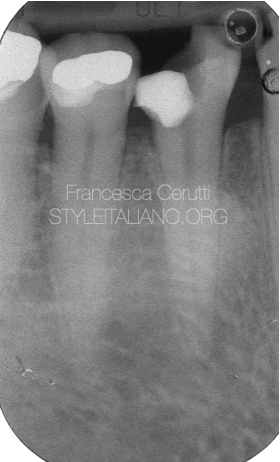
Fig. 2
The pre operative periapical X-ray shows the presence of a decay and the compromission of the pulp. The diagnosis is irreversible pulpitis of the lower right first premolar, the therapy is endodontic treatment.

Fig. 3
After doing the anesthesia and isolating the tooth, the access cavity was done. In this case in was enough to remove all the decay to gain straight accesso to the root canal system.

Fig. 4
A mechanical glide path was done by using a series of Ni-Ti instruments short to the estimated WL. First of all a 13.03 instrument was used.
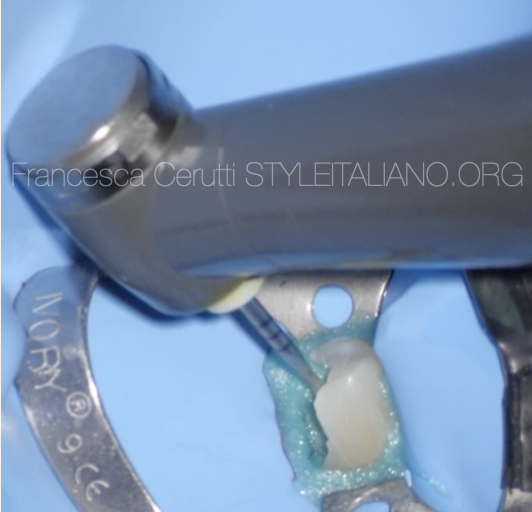
Fig. 5
Then it was possible to use a 20.04 file, without applying pressure, just to pre-flare the root canal.
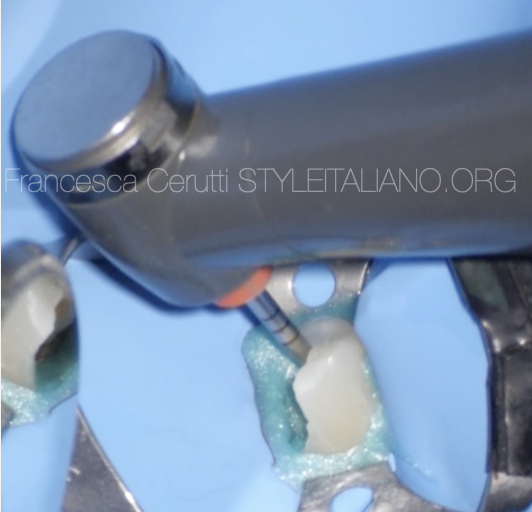
Fig. 6
Since the anatomy of the root allowed it, a 25.06 file was used in the same way.
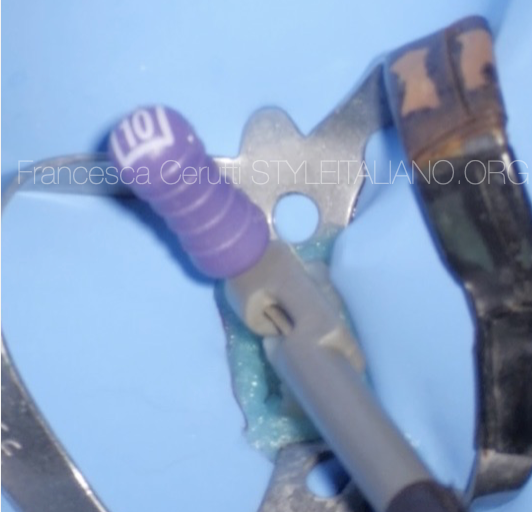
Fig. 7
The working length was recorded with a #10 K-file and electronic apex locator.
After recording the working length, the selected rotary file system was used to shape the root canal up to 35 .04

Fig. 8
After that, the irrigation phase was carried out with 5,25% Sodium Hypochlorite.
The video shows the irrigant in action
In order to give a boost to the effect of the irrigant, a ultrasonic K-File was used to activate it.

Fig. 9
Since it was chosen to obturate the root canal system with the WVC technique, the selected gutta percha point was tried until it fit the root canal preparation.

Fig. 10
The root canal was dried with sterile paper points. The presence of a small blood spot on the side of the paper point suggests the presence of a lateral canal in that area.

Fig. 11
The canal is clean, dry and ready to be filled.
It was decided to use EssenSeal (Produits Dentaires SA, Vevey, Switzerland) as a root canal sealer.
EssenSeal (Produits Dentaires SA, Vevey, Switzerland) is a powder-liquid cement highly flowable with low paste thickness, that should be mixed according with manufacturer’s instruction, 1 drop of liquid with 1 of the provided spoon of powder.
The powder should be gradually incorporated into the liquid and the product should be mixed until it reaches a creamy consistency and a shiny appearance.
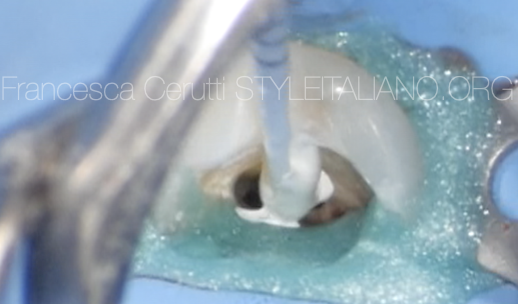
Fig. 12
The sealer was applied into the root canal by means of a paper point.

Fig. 13
The filling was done with the warm vertical compaction of the gutta percha technique.

Fig. 14
Post-operative X-ray after the restoration
Conclusions
After the treatment the patient was free from pain. He was scheduled for a treatment plan involving the occlusal rehabilitation of the whole mouth.
EssenSeal (Produits Dentaires SA, Vevey, Switzerland), besides the good handling and the pleasant scent, has the capability to penetrate smoothly into the root canals, filling also the lateral canals without any voids.
Bibliography
1. Libonati, A., et al., Percentage of Gutta-percha-filled Areas in Canals Obturated by 3 Different Techniques with and without the Use of Endodontic Sealer. J Endod, 2018. 44(3): p. 506-509.
2. Gunes, B., et al., Dentinal tubule penetration of endodontic sealers after nontherma plasma treatment: A confocal laser scanning microscopy study. Microsc Res Tech, 2019: p. 1,6.
3. Li, G., et al., Ability of new obturation materials to improve the seal of the root canal system: A review. Acta Biomat, 2014. 10: p. 1050-63.
5. AlShwaimi, E., et al., In Vitro Antimicrobial Effectiveness of Root Canal Sealers against Enterococcus faecalis: A Systematic Review. J Endod, 2016. 42(11): p. 1588-1597.
6. Chandrasekhar, V., et al., Expansion of gutta-percha in contact with various concentrations of zinc oxide-eugenol sealer: a three-dimensional volumetric study. J Endod, 2011. 37(5): p. 697-700.
7. Michaud, R.A., et al., Volumetric expansion of gutta-percha in contact with eugenol. J Endod, 2008. 12: p. 1528–32.
8. De-Deus, G., et al., Lack of correlation between sealer penetration into dentinal tubules and sealability in nonbonded root fillings. Int Endod J, 2012. 45(7): p. 642-51.
9. Russell, A.A., L.T. Friedlander, and N. Chandler, Sealer penetration and adaptation in root canals with the butterfly effect. Aust Endod J, 2017: p. 1-10.
10. Libonati, A., et al., Percentage of Gutta-percha-filled Areas in Canals Obturated by 3 Different Techniques with and without the Use of Endodontic Sealer. J Endod, 2017.
11. Hammer, K.A., et al., Susceptibility of oral bacteria to Melaleuca alternifolia (tea tree) oil in vitro. Microbiol Immunol, 2003. 18: p. 389-92.
12. Straede, A., et al., The effect of tea tree oil and antifungal agents on a reporter for yeast cell integrity signalling. Yeast, 2007. 24: p. 321–34.



